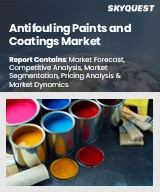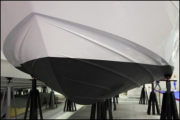
|
시장보고서
상품코드
1800972
방오 페인트 및 코팅 시장 보고서 : 유형, 용도, 지역별(2025-2033년)Antifouling Paints and Coatings Market Report by Type, Application, and Region 2025-2033 |
||||||
방오 페인트 및 코팅 세계 시장 규모는 2024년 100억 달러에 달했습니다. IMARC Group은 2033년에는 178억 달러에 달하고, 2025-2033년 6.3%의 연평균 성장률(CAGR)을 보일 것으로 예측했습니다.
방오 페인트 및 코팅은 선박 및 해양 구조물의 선저에 도포되어 수중 생물의 번식을 최소화하거나 방지하기 위한 특수 도료를 말합니다. 방오도료는 수지, 안료, 산화제일구리, 살생물제 등을 사용하여 제조되며, 조류, 박테리아, 규조류, 규조류, 따개비, 슬라임 등 해양생물의 증식을 억제합니다. 일반적으로 사용되는 방오 페인트에는 연질 바닥 도료, 경질 바닥 도료, 연마제 방오 페인트 등이 있습니다. 보트, 요트, 선박의 선체를 통과하는 물의 흐름을 개선하고, 저항을 줄여 연료 소비를 최소화하며, 선박의 내구성과 미적 가치를 높이기 위해 보트, 요트, 선박의 바닥에 적용됩니다.
세계 해양 및 조선 산업의 괄목할만한 성장은 시장에 긍정적인 영향을 미치는 주요 요인 중 하나입니다. 또한, 선박의 내구성 향상과 부식 방지에 대한 관심과 지출이 증가하고 있는 것도 시장 성장을 가속하고 있습니다. 방오 페인트 및 코팅은 시추 장비, 생산 플랫폼, 선박, 내륙 수로 운송에 사용되어 마찰 저항을 줄이고 오염 생물에 의한 선체 손상을 방지합니다. 또한, 친환경 방오 제품 개발 등 다양한 제품 혁신이 또 다른 성장 촉진요인으로 작용하고 있습니다. 또한, 저마찰, 무금속, 실리콘 및 불소 수지 기반의 방오 페인트 및 코팅에 대한 수요가 증가하고 있으며, 이는 시장 성장에 기여하고 있습니다. 이 외에도 레저보트 보유율 증가, 석유 및 가스업계의 FPSO(부유식 원유 생산저장하역설비) 선박에 대한 수요 증가 등이 시장을 더욱 견인할 것으로 예측됩니다.
본 보고서에서 다룬 주요 질문
- 2024년 세계 방오 페인트 및 코팅 시장 규모는?
- 2025-2033년 방오 페인트 및 코팅 세계 시장 성장률 전망은?
- 방오 페인트 및 코팅 세계 시장을 이끄는 주요 요인은?
- 코로나19가 세계 방오 페인트 및 코팅제 시장에 미치는 영향은?
- 세계 방오 페인트 및 코팅제 시장의 유형별 분류는?
- 방오 페인트 및 코팅 세계 시장 용도별 분류는?
- 방오 페인트 및 코팅 세계 시장에서 주요 지역은?
- 방오 페인트 및 코팅 세계 시장에서 주요 기업은?
목차
제1장 서문
제2장 조사 범위와 조사 방법
- 조사 목적
- 이해관계자
- 데이터 소스
- 1차 정보
- 2차 정보
- 시장 추정
- 보텀업 접근
- 톱다운 접근
- 조사 방법
제3장 주요 요약
제4장 서론
제5장 세계의 방오 페인트 및 코팅 시장
- 시장 개요
- 시장 실적
- COVID-19의 영향
- 시장 예측
제6장 시장 분석 : 유형별
- 구리 기반
- 자기 연마 코폴리머
- 실리콘 엘라스토머
- 기타
제7장 시장 분석 : 용도별
- 운송 선박
- 시추 리그 및 생산 플랫폼
- 어선
- 요트 및 기타 보트
- 낙하산 연결 케이블
- 내륙수로
제8장 시장 분석 : 지역별
- 북미
- 미국
- 캐나다
- 아시아태평양
- 중국
- 일본
- 인도
- 한국
- 호주
- 인도네시아
- 기타
- 유럽
- 독일
- 프랑스
- 영국
- 이탈리아
- 스페인
- 러시아
- 기타
- 라틴아메리카
- 브라질
- 멕시코
- 기타
- 중동 및 아프리카
제9장 SWOT 분석
제10장 밸류체인 분석
제11장 Porter의 Five Forces 분석
제12장 가격 분석
제13장 경쟁 구도
- 시장 구조
- 주요 기업
- 주요 기업 개요
- Akzo Nobel N.V.
- BASF S.E.
- Boero Yacht Coatings
- Chugoku Marine Paints Ltd.
- Hempel A/S
- Jotun Group
- Kop-Coat Marine Group(RPM International Inc.)
- Nippon Paint Marine Coatings Co. Ltd.
- PPG Industries Inc.
- The Sherwin-Williams Company
The global antifouling paints and coatings market size reached USD 10.0 Billion in 2024. Looking forward, IMARC Group expects the market to reach USD 17.8 Billion by 2033, exhibiting a growth rate (CAGR) of 6.3% during 2025-2033.
Antifouling paints and coatings refer to specialized paints applied to the hulls of ships and offshore structures to minimize or prevent the growth of sub-aquatic organisms. They are manufactured using resins, pigments, cuprous oxides and biocides, which inhibit the growth of algae, bacteria, diatoms, barnacles, slime and other marine organisms. Some of the commonly used antifouling paints, include soft-bottom paint, hard-bottom paint and ablative antifouling paints. They are applied to the bottom of the boats, yachts and ships to improve the flow of water passing the hull, which minimizes fuel consumption by reducing the drag and enhancing the durability and aesthetic value of the ship.
Significant growth in the marine and shipbuilding industries across the globe is one of the key factors creating a positive impact on the market. Furthermore, increasing focus and expenditures on improving vessel durability and preventing corrosion are providing a thrust to the market growth. Antifouling paints and coatings are used on drilling rigs, production platforms, shipping vessels and inland waterways transport to reduce frictional resistance and prevent fouling organisms from damaging the hulls. Additionally, various product innovations, such as the development of environment-friendly antifouling products, are acting as other growth-inducing factors. There is also a growing demand for low-friction, metal-free and silicone- and fluoro resin-based antifouling paints and coatings, which is contributing to the market growth. Other factors, including increasing ownership of leisure boats, along with the growing demand for floating production storage and offloading (FPSO) vessels by the oil and gas industry, are anticipated to drive the market further.
Key Market Segmentation:
Breakup by Type:
- Copper-Based
- Self-Polishing Copolymer
- Silicone Elastomers
- Others
Breakup by Application:
- Shipping Vessels
- Drilling Rigs & Production Platforms
- Fishing Boats
- Yachts & Other Boats
- Mooring Lines
- Inland Waterways
Breakup by Region:
- North America
- United States
- Canada
- Asia Pacific
- China
- Japan
- India
- South Korea
- Australia
- Indonesia
- Others
- Europe
- Germany
- France
- United Kingdom
- Italy
- Spain
- Russia
- Others
- Latin America
- Brazil
- Mexico
- Others
- Middle East and Africa
Competitive Landscape:
The report has also analysed the competitive landscape of the market with some of the key players being Akzo Nobel N.V., BASF S.E., Boero Yacht Coatings, Chugoku Marine Paints Ltd., Hempel A/S, Jotun Group, Kop-Coat Marine Group (RPM International Inc), Nippon Paint Marine Coatings Co. Ltd., PPG Industries Inc. and The Sherwin-Williams Company etc.
Key Questions Answered in This Report
- 1.What was the size of the global antifouling paints and coatings market in 2024?
- 2.What is the expected growth rate of the global antifouling paints and coatings market during 2025-2033?
- 3.What are the key factors driving the global antifouling paints and coatings market?
- 4.What has been the impact of COVID-19 on the global antifouling paints and coatings market?
- 5.What is the breakup of the global antifouling paints and coatings market based on the type?
- 6.What is the breakup of the global antifouling paints and coatings market based on the application?
- 7.What are the key regions in the global antifouling paints and coatings market?
- 8.Who are the key players/companies in the global antifouling paints and coatings market?
Table of Contents
1 Preface
2 Scope and Methodology
- 2.1 Objectives of the Study
- 2.2 Stakeholders
- 2.3 Data Sources
- 2.3.1 Primary Sources
- 2.3.2 Secondary Sources
- 2.4 Market Estimation
- 2.4.1 Bottom-Up Approach
- 2.4.2 Top-Down Approach
- 2.5 Forecasting Methodology
3 Executive Summary
4 Introduction
- 4.1 Overview
- 4.2 Key Industry Trends
5 Global Antifouling Paints and Coatings Market
- 5.1 Market Overview
- 5.2 Market Performance
- 5.3 Impact of COVID-19
- 5.4 Market Forecast
6 Market Breakup by Type
- 6.1 Copper-Based
- 6.1.1 Market Trends
- 6.1.2 Market Forecast
- 6.2 Self-Polishing Copolymer
- 6.2.1 Market Trends
- 6.2.2 Market Forecast
- 6.3 Silicone Elastomers
- 6.3.1 Market Trends
- 6.3.2 Market Forecast
- 6.4 Others
- 6.4.1 Market Trends
- 6.4.2 Market Forecast
7 Market Breakup by Application
- 7.1 Shipping Vessels
- 7.1.1 Market Trends
- 7.1.2 Market Forecast
- 7.2 Drilling Rigs & Production Platforms
- 7.2.1 Market Trends
- 7.2.2 Market Forecast
- 7.3 Fishing Boats
- 7.3.1 Market Trends
- 7.3.2 Market Forecast
- 7.4 Yachts & Other Boats
- 7.4.1 Market Trends
- 7.4.2 Market Forecast
- 7.5 Mooring Lines
- 7.5.1 Market Trends
- 7.5.2 Market Forecast
- 7.6 Inland Waterways
- 7.6.1 Market Trends
- 7.6.2 Market Forecast
8 Market Breakup by Region
- 8.1 North America
- 8.1.1 United States
- 8.1.1.1 Market Trends
- 8.1.1.2 Market Forecast
- 8.1.2 Canada
- 8.1.2.1 Market Trends
- 8.1.2.2 Market Forecast
- 8.1.1 United States
- 8.2 Asia Pacific
- 8.2.1 China
- 8.2.1.1 Market Trends
- 8.2.1.2 Market Forecast
- 8.2.2 Japan
- 8.2.2.1 Market Trends
- 8.2.2.2 Market Forecast
- 8.2.3 India
- 8.2.3.1 Market Trends
- 8.2.3.2 Market Forecast
- 8.2.4 South Korea
- 8.2.4.1 Market Trends
- 8.2.4.2 Market Forecast
- 8.2.5 Australia
- 8.2.5.1 Market Trends
- 8.2.5.2 Market Forecast
- 8.2.6 Indonesia
- 8.2.6.1 Market Trends
- 8.2.6.2 Market Forecast
- 8.2.7 Others
- 8.2.7.1 Market Trends
- 8.2.7.2 Market Forecast
- 8.2.1 China
- 8.3 Europe
- 8.3.1 Germany
- 8.3.1.1 Market Trends
- 8.3.1.2 Market Forecast
- 8.3.2 France
- 8.3.2.1 Market Trends
- 8.3.2.2 Market Forecast
- 8.3.3 United Kingdom
- 8.3.3.1 Market Trends
- 8.3.3.2 Market Forecast
- 8.3.4 Italy
- 8.3.4.1 Market Trends
- 8.3.4.2 Market Forecast
- 8.3.5 Spain
- 8.3.5.1 Market Trends
- 8.3.5.2 Market Forecast
- 8.3.6 Russia
- 8.3.6.1 Market Trends
- 8.3.6.2 Market Forecast
- 8.3.7 Others
- 8.3.7.1 Market Trends
- 8.3.7.2 Market Forecast
- 8.3.1 Germany
- 8.4 Latin America
- 8.4.1 Brazil
- 8.4.1.1 Market Trends
- 8.4.1.2 Market Forecast
- 8.4.2 Mexico
- 8.4.2.1 Market Trends
- 8.4.2.2 Market Forecast
- 8.4.3 Others
- 8.4.3.1 Market Trends
- 8.4.3.2 Market Forecast
- 8.4.1 Brazil
- 8.5 Middle East and Africa
- 8.5.1 Market Trends
- 8.5.2 Market Breakup by Country
- 8.5.3 Market Forecast
9 SWOT Analysis
- 9.1 Overview
- 9.2 Strengths
- 9.3 Weaknesses
- 9.4 Opportunities
- 9.5 Threats
10 Value Chain Analysis
11 Porters Five Forces Analysis
- 11.1 Overview
- 11.2 Bargaining Power of Buyers
- 11.3 Bargaining Power of Suppliers
- 11.4 Degree of Competition
- 11.5 Threat of New Entrants
- 11.6 Threat of Substitutes
12 Price Analysis
13 Competitive Landscape
- 13.1 Market Structure
- 13.2 Key Players
- 13.3 Profiles of Key Players
- 13.3.1 Akzo Nobel N.V.
- 13.3.1.1 Company Overview
- 13.3.1.2 Product Portfolio
- 13.3.1.3 Financials
- 13.3.1.4 SWOT Analysis
- 13.3.2 BASF S.E.
- 13.3.2.1 Company Overview
- 13.3.2.2 Product Portfolio
- 13.3.2.3 Financials
- 13.3.2.4 SWOT Analysis
- 13.3.3 Boero Yacht Coatings
- 13.3.3.1 Company Overview
- 13.3.3.2 Product Portfolio
- 13.3.4 Chugoku Marine Paints Ltd.
- 13.3.4.1 Company Overview
- 13.3.4.2 Product Portfolio
- 13.3.4.3 Financials
- 13.3.4.4 SWOT Analysis
- 13.3.5 Hempel A/S
- 13.3.5.1 Company Overview
- 13.3.5.2 Product Portfolio
- 13.3.5.3 SWOT Analysis
- 13.3.6 Jotun Group
- 13.3.6.1 Company Overview
- 13.3.6.2 Product Portfolio
- 13.3.6.3 SWOT Analysis
- 13.3.7 Kop-Coat Marine Group (RPM International Inc.)
- 13.3.7.1 Company Overview
- 13.3.7.2 Product Portfolio
- 13.3.8 Nippon Paint Marine Coatings Co. Ltd.
- 13.3.8.1 Company Overview
- 13.3.8.2 Product Portfolio
- 13.3.9 PPG Industries Inc.
- 13.3.9.1 Company Overview
- 13.3.9.2 Product Portfolio
- 13.3.9.3 Financials
- 13.3.9.4 SWOT Analysis
- 13.3.10 The Sherwin-Williams Company
- 13.3.10.1 Company Overview
- 13.3.10.2 Product Portfolio
- 13.3.10.3 Financials
- 13.3.10.4 SWOT Analysis
- 13.3.1 Akzo Nobel N.V.



















